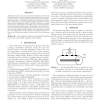Free Online Productivity Tools
i2Speak
i2Symbol
i2OCR
iTex2Img
iWeb2Print
iWeb2Shot
i2Type
iPdf2Split
iPdf2Merge
i2Bopomofo
i2Arabic
i2Style
i2Image
i2PDF
iLatex2Rtf
Sci2ools
96
Voted
CCECE
2006
IEEE
2006
IEEE
Blood Impedance Characterization from Pulsatile Measurements
This paper describes an in vivo measurement technique to calculate dielectric properties of blood excluding the contributions from surrounding tissues, based on analysis of the pulsatile component bioimpedance spectroscopy data. A tetrapolar electrode system applied on the fingers is simulated by a pspice equivalent circuit, and current is injected with frequency ranging from 5 kHz to 100 MHz. The finger is modeled as three parts: arterial blood, surrounding tissues and incremental infused arterial blood during systole. The pulsatile curve is fitted to a Cole-Cole model by Levenberg-Marquardt (LM) nonlinear curve fitting. Using the pulsatile impedance data, electrical properties of blood and surrounding tissues can be separated successfully. Parameter accuracies are illustrated according to various noise levels and sampling rates. Keywords—Bioimpedance spectroscopy; pulsatile impedance wave; Cole-Cole model; nonlinear curve fitting.
Arterial Blood | CCECE 2006 | Cole-Cole Model | Electrical And Computer Engineering | Nonlinear Curve |
Related Content
| Added | 10 Jun 2010 |
| Updated | 10 Jun 2010 |
| Type | Conference |
| Year | 2006 |
| Where | CCECE |
| Authors | Tao Dai, Andy Adler |
Comments (0)

